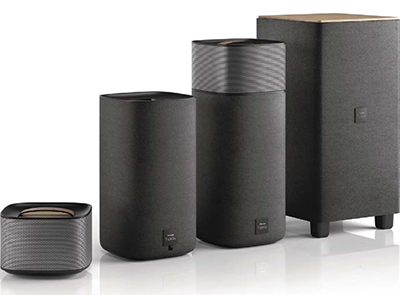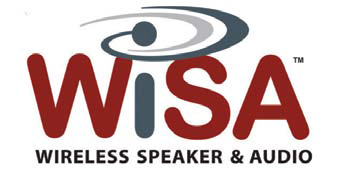TV Audio Advances
Television screens are getting bigger and sexier, but the audio technology in them seems to have stagnated. Connections haven’t changed other than an upgrade to HDMI 2.0 for some. There is good news however, with more mention of front-facing speakers instead of down facing, and more manufacturers including multiple drivers instead of single small speakers.

Philips’ Fidelio E5 is a 4.1 speaker system, with Bluetooth and Near Field Communications. If you happen to have incredibly deep pockets, you can pick up the 105-inch LG Ultra HD curved, 21:9 aspect ratio television with 7.2 multichannel sound provided by Harman Kardon. Then there is the Sharp Aquos Ultra HD with six front facing speakers, including tweeters, midrange, and dual subwoofers, all powered by an underwhelming 35 Watts of power. Honestly, it has to be hard to get decent sounding speakers into a box as thin as television displays have become, which may be why LG is outfitting its Gallery OLED TVs with something called a canvas speaker that delivers 2.2 channels of audio with 100 Watts of power. The canvas speaker tech remains totally mysterious and whether they sound good or are simply a tie-in to the Gallery display name remains to be seen.
Fortunately, manufacturers have come up with a solution to poor sounding televisions: sound bars and sound stands. Reviews for these speaker systems, which try to emulate either front array or full surround imaging, run the gamut from OK to really great. Most television manufacturers had sound bars on display, with the GoldenEar 3D Array sound bar generating the most attention. Sound bases, which are like sound bars but are also a base for the television to sit on top of, seem to be coming on strong this year, with the Vizio Sound Stand, LG SoundPlate, Samsung HW-H600 Sound Stand, and Sony HT-XT1 Speaker Base among models announced at the show.
WIRELESS WOWS
Wireless technology was the real surprise for me coming out of this year’s show. Wireless HDMI seems to be on the immediate horizon, but there were lots of wireless audio products too. Philips was showing the Fidelio E5 speaker system, oddly a 4.1 system, with Bluetooth and Near Field Communications. The subwoofer and surround speakers connect to the left and right speakers via Bluetooth and NFC is used to connect tablets, smartphones, and other compatible devices. Samsung expanded its Shape series wireless speaker system, which also uses Bluetooth and NFC technologies. HD audio streaming over Wi-Fi is promised as part of a wireless technology from Broadcom called Wireless Internet Connectivity for Embedded Devices. WICED actually uses Wi-Fi, Bluetooth, and NFC to connect not just audio devices, but home appliances, other electronics, and personal wearable technology as well.

The truly interesting wireless audio products were those using technology from Wireless Speaker and Audio. The system claims to be able to wirelessly transmit 7.1 channels of audio at up to 24-bit, 96 kHz, with 5 ms fixed latency, in all directions, with less than 160 ns delay between speakers. To help it stay free from interference from Bluetooth and Wi-Fi signals, the technology operates in the 5.2 to 5.8 GHz UNII bands. Bang & Olufsen demonstrated its BeoLab transmitters and receivers using WiSA that wirelessly connects their televisions and sound systems to their active speakers. Since all technology demos need source material, Sharp introduced their WiSA-enabled SD-WH1000U Universal Disc Player, which according to the manufacturer, “is the first component to transmit uncompressed sound at 24-bit/96kHz and video at Full HD (1080p)—wirelessly.” In addition to B&O and Sharp, WiSA has also signed on Onkyo, Pioneer, Polk, Gibson, Klipsch and others manufacturers to provide enabled devices. If these technologies work as promised, and if cost is kept under control, we may finally have a solution to running speaker cables all over the living room.
There were a few other tidbits from the show that are worth mentioning here because they’re all encouraging signs for the television audio industry. First is that headphones are back in a big way, with lots of high-end models being released. Hopefully this means that people are starting to listen more critically and are caring more about quality sound, but it certainly shows that the personal audio market continues to grow. Auro Technologies has announced that its immersive surround format, Auro- 3D, is coming to the home with the introduction of the Auro-3D ISSP 12.200D AV Receiver. Sony introduced the PCM-D100 portable audio recorder, which records in Direct Stream Digital format, and announced plans to bring lots of high-resolution audio products to the home.
Finally and surprisingly, Harmonic, in its end-to-end 4K transmission demos, showed that its system can handle 5.1 and 7.1, can downmix those formats, and output a host of audio codec formats including MPEG-1 L2, AAC-LC, and a couple of flavors of HEAAC. I didn’t expect to see any successful 4K transmission demos anytime soon, so I find this incredibly encouraging for the future of 4K broadcast television.
Jay Yeary is a television audio engineer who spends his days working for a large media corporation. In past lives he has worked as a live sound engineer, music editor, and sound designer. He is thrilled that high quality headphones are making a comeback and plans to use this as justification for his addiction to them. He can be contacted throughTV Technologyor via Twitter at @TVTechJay.
Get the TV Tech Newsletter
The professional video industry's #1 source for news, trends and product and tech information. Sign up below.
